On 6th April the Port Phillip Gazette published an article about the various denominations present in Melbourne at the time and their relative strength. I’ve never thought of Melbourne as being a particularly Catholic city, although even as I write this, I think of the prominence of Archbishop Mannix, and the Catholic-Protestant riots that were about to break out in Melbourne in 1843. I’ve always thought of Melbourne being more Presbyterian or Anglican, perhaps because of the more visible presence of their large city churches in Melbourne today. Nonetheless, it’s interesting that during 1842, the Catholic church was the most prominent in Melbourne with the Church of England coming a poor fifth. According to the Gazette, in order of size the churches were:
1. The Roman Catholics
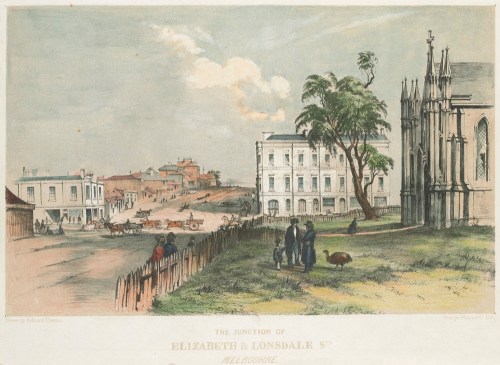
Edmund Thomas The junction of Elizabeth and Lonsdale Streets, 1853 (some ten years later). St Francis’ church is on the right hand side. Love the emu in the front garden (as if!) Source: State Library of Victoria
http://handle.slv.vic.gov.au/10381/223224
I. — The Church of Rome, first formed under the Rev. Mr. Geogheghan, in 1839, now under the spiritual charge of the Rev. Mr. Stevens, has the largest number of communicants among the churches of Melbourne ; the attendance varies from seven hundred to a thousand souls; the permanent place of worship standing in Elizabeth street, is a neat gothic Chapel, constructed of brick; and calculated to hold a thousand sitting when completed; occasionally an assistant priest or deacon, is sent from Sydney, but no estimate has yet been allowed by Government for the stipend of a second priest.
2. The Wesleyan Methodists
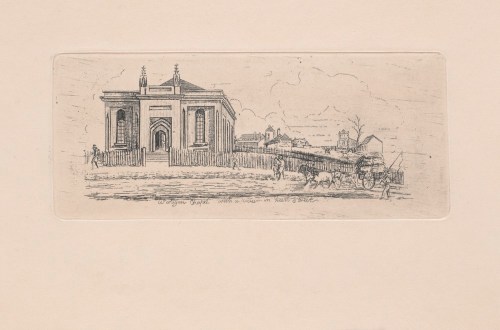
Henry Gilbert Jones (1804-1888) Wesleyan Chapel with a View in Queen Street Source: State Library of Victoria
http://handle.slv.vic.gov.au/10381/13069
II. — The Wesleyan Church ; the members of this society who are the followers of the celebrated divine Wesley, have fulfilled the observances of congregational meetings from the earliest times of the settlement, but were not provided, until lately, with a resident minister. The branch in Melbourne was at one time attached to the Church in Van Diemen’s Land, but has since been placed under. the charge of the Chairman in Sydney; the Rev. Mr. Orton, a Wesleyan Missionary, having resigned his duties in New South Wales, was induced to supply the urgent want of ministerial labour, but was lately relieved by the Rev. Mr. Wilkinson, appointed by the proper authorities at home ; their chapel which is situated in Collins-street, is attended by eight hundred people, and will require shortly to be enlarged to give more accommodation ; great pains have been bestowed on the vocal and instrumental music in the Wesleyan chapel and the exhortations of the minister, the prayers of the congregation, effectively blend with the innocent and harmonious attractions of the choir and organ; there are also ten local preachers attached to the congregations whose talents are a powerful aid to their spiritual ends.
3. Presbyterians
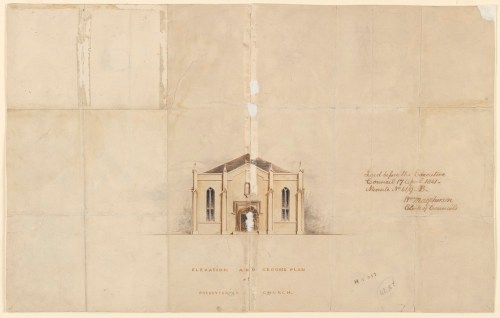
Samuel Jackson 1807-1876, architect, Elevation and Ground Plan of Presbyterian Church (i.e. Scots Church, Collins St, Melbourne) (Technical Drawing) 1841. Source: State Library of Victoria
http://handle.slv.vic.gov.au/10381/120261
III. — The Presbyterians are a body in connection with the established Church of Scotland, the ministers of the provincial congregations acknowledging the superin- tendence of the synod of New South Wales whose place of convention is in Sydney. ‘The attendants at the Kirk in Melbourne are about equal to those of the Wesleyan body, and are under the zealous ministry of the Reverend Mr. Forbes, whose great desire has been to obtain as many assist-ants as possible for the religious instruction of the neighbouring districts; the Committee for Colonial Churches of the General Assembly in Scotland, has granted considerable assistance, by providing, no less than four ministers who are either forming congregations, or, have already received a call. The Reverend Mr. Clow, a private settler in Port Phillip, and formerly a chaplain on the East India Company’s establishment for the Kirk, in Bombay, was the earliest ministering clergyman to the Presbyterians of Melbourne, Mr. Forbes, the present incumbent, having having taken charge in 1838. This gentle man has signalised his ministry by his care for the advancement of education; and of the construction and character of the Scots’ School, we shall have much to say in the notice we shall devote hereafter, to the Schools of Melbourne; the permanent place of worship known as the Scots’ Church, is built on the Eastern Hill, or Collins-street East, and has been open for some time to congregational purposes, but is not quite finished in its interior arrangements.
4. Independents
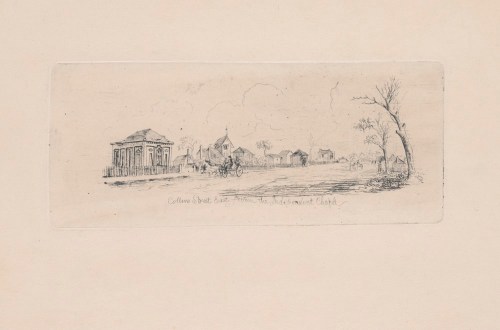
Henry Gilbert Jones (1804 – 1888) Collins Street East from the Independent Chapel. Source: State Library of Victoria.
http://handle.slv.vic.gov.au/10381/130647
IV. — The Independents are a highly zealous and respectable body, under the ministry of the Rev. Mr. Waterfield, an amiable pastor of their church, who arrived in Melbourne in 1838, and commenced the formation of the community, over which he now exercises his professional charge ; like the clergymen of other establishments he might be a stipendiary of the Government, but in strict obedience to the principles of his church, he receives his support from the voluntary contributions of his communicants and attendants. The Independent Chapel was the first permanent place of worship completed and opened in Melbourne ; it has a facial plainness which consorts well with the neat conveniences of the interior, it is built in Collins-street, and neighbours with the Scots’ Kirk; the sittings are capable of accommodating about six hundred which nearly approaches the total muster of its congregation.
5. Church of England
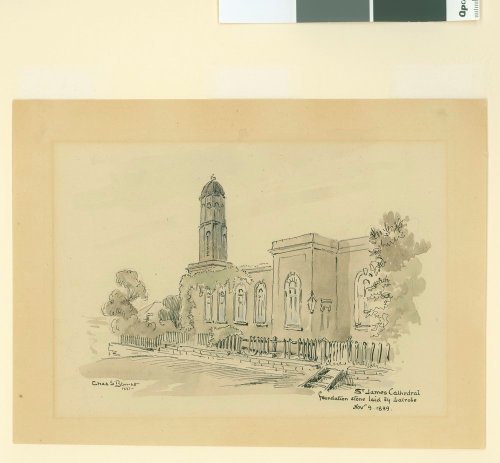
Chas.S.Bennett (1869-1930) St James Cathedral. This image was drawn in 1881 when the church was in its original location near the corner of Little Collins St and William Street. It was shifted to the corner of King and Batman Streets in 1913-14. Source: State Library of Victoria
http://handle.slv.vic.gov.au/10381/72322
The Church of St. James on the English establishment is shewing a front which no longer leaves it marked with inferiority ; the structure is as far advanced as that of the Roman Catholic Chapel, although the difference of materials and interior fittings, will place it last in the race of competition..
V. — The Church of England is the oldest in point of foundation but the last in scope of attainments ; mismanagement of its temporalities has done much to retard its growth, but later exertions have given it an impetus that will, we anticipate, insure the recovery of its proper position. For some period after the formation of the settlement, such part of the church services as may be performed by laymen were industriously discharged by Mr. James Smith, who was relieved in 1838 by the Rev. Mr. Grylls. At that time subscription lists were opened in aid of the permanent church, and other steps taken for the accommodation of the adherents. The circumstances to which we have alluded, but upon which we do not wish to expatiate, retarded the growth of the congregation and the completion of the church ; the former now consists of about four hundred members, out of a return certified by the census of two thousand in the town and its vicinity ; the latter will be a handsome stone edifice, built in a durable and costly style; when finished, which may be looked for in three or four months, the accommodation afforded will be the means, we trust, of re-uniting a community at present scattered and neglected. The Rev. Mr. Wilson, who succeeded Mr. Grylls, now translated to the incumbency of St. Phillip’s in Sydney, is about to proceed to Portland with the view of founding another church, while the Rev. Mr. Thomson remains as the minister of St. James’s, in Melbourne.
6. The others
VI. — Besides these are small bodies of Quakers, Baptists, and Jews, but whose numerical strength is as yet severally too small for the formation of a regular community. union bank.
